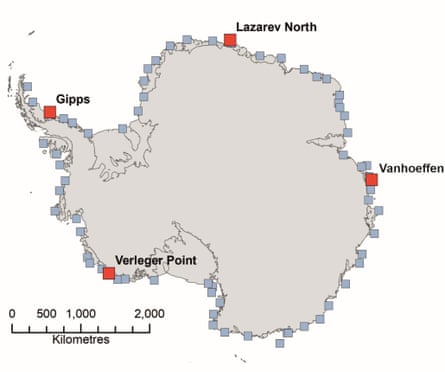Four new emperor penguin colonies have been discovered in Antarctica after their guano was spotted from space, giving what a leading scientist believes is a near-full picture of the species’ population as it comes under threat due to disappearing sea ice.

A peer-reviewed study last year found a record drop in the amount of floating sea ice in the Bellingshausen Sea in late 2022 could have caused a “catastrophic breeding failure” that killed thousands of emperor penguin chicks across four breeding colonies.
The latest study found four new colonies that had not been previously recorded and what was thought to be the re-establishment of one that was believed lost. If correct, it has moved 30km east, from Halley Bay to near a rise in ice known as the MacDonald Ice Rumples.
Dr Peter Fretwell, a geospatial scientist with the British Antarctic Survey, used satellite imagery to discover and monitor the remote colonies, being guided by the brown stains of the penguins’ guano – poo – on the white ice and snow. His research, published in the journal Antarctic Science, said the discoveries lifted the number of known emperor penguin colonies to 66.
“These newly identified locations fill in almost all the gaps in the known distribution of these iconic birds,” he said.
“All except one of these colonies are small with less than 1,000 birds, so finding these new colonies makes little difference to the overall population size. In fact, it is overshadowed by the recently reported breeding failures due to the early and fast ice loss.”

Emperor penguins are the largest but least prevalent Antarctic penguin species, with scientists estimating a total population of about 600,000. They depend on stable sea ice – formed when the ocean surface freezes but attached to the shore, and known as land-fast ice – for breeding. They lay eggs in May and June. Chicks are born 65 days later, but typically do not fledge until December or January.
That cycle is threatened by a sharp decline in sea ice extent. The past two years have been the lowest for sea ice cover since the satellite record began in 1979. The four lowest years on record have occurred since 2016.
Fretwell said predictions of future changes in the emperor penguin population due to the climate crisis were stark. About 30% of emperor penguin colonies are believed to have been affected by sea ice loss since 2018.
His paper cited models that suggested if carbon dioxide emissions continued to rise at the present rate almost all colonies would be “quasi-extinct” by the end of the century. Global leaders have set targets to make sharp reductions in emissions from burning fossil fuels, but they continued to increase last year.
